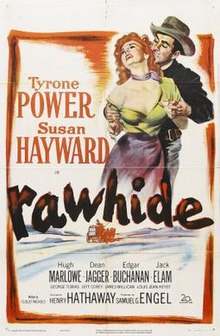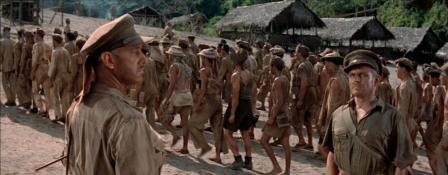A small-scale Western with well-drawn characters and a lot of tension.
A person being held captive, under whatever circumstances—by incapacity, by a domineering criminal or legally—is one of the most popular of film plots. From among the many varieties, and with the numerous variations on the standard plots, what really matters in the end is whether or not the imprisoned escapes. Of course, this depends upon the nature of character, ingenuity . . . and luck.
The simplest and the easiest situation to script, being only two basic characters, is the lone keeper and the one prisoner. An obvious example of this is The Collector (1965). Terence Stamp, a socially backward bank clerk, imprisons art student Samantha Eggar, who, despite all sorts of ploys to escape, ends up dead. And Stamp—this long after the watchdog Hays Office when any wrongdoings required last-scene retribution—is allowed to stalk another woman.
In Lady in a Cage (1964), another woman victim, who in this case manages to escape alive, though battered and hysterical, is tormented by three hooligans. Olivia de Havilland spends most of the film in a cage-like elevator she had installed in her home.
The cast of keeper and hostage increases in Suddenly (1954). Three escaped convicts, including Frank Sinatra, commandeer a residential home and its five individuals. The criminals plan to assassinate the President of the United States when he makes a train stop. After the bad guys and one hostage die, the President’s train passes on through without stopping.
By far the most popular type of prisoner is the one incarcerated in the very institution which symbolizes confinement, the edifice of a prison itself. Here again, diversity abounds—maybe a Western prison as in There Was a Crooked Man (1970), prisoner Kirk Douglas pitted against warden Henry Fonda, or a modern, high-security prison with Tim Robbins breaking out in The Shawshank Redemption (1994), leaving this warden, Bob Gunton, to kill himself after Robbins has exposed his laundered money scheme.
Two of the greatest prison movies are those which evolved from yet another evil of war, the concentration camp. Of the prison camps of World War II, the Japanese camps were the most notorious (Three Came Home, 1950, The Bridge on the River Kwai, 1957, and King Rat, 1965). In the more lenient German camps—this distinguished, now, from the concentration camps—some levity somehow is permitted. In Stalag 17 (1953) William Holden and Don Taylor are the only escapees, and in The Great Escape (1963) top-billed Steve McQueen is recaptured.
Among penal prisons, those on islands only make escape more of a challenge for the would-be escapee. In The Prisoner of Shark Island (1936), the mistakenly imprisoned Dr. Samuel Mudd (Warner Baxter), who treated John Wilkes Booth’s wound, is incarcerated at Fort Jefferson in theDry Tortugas. In Papillon (1973), both Steve McQueen and Dustin Hoffman have the misfortune to be imprisoned on infamous Devil’s Island.
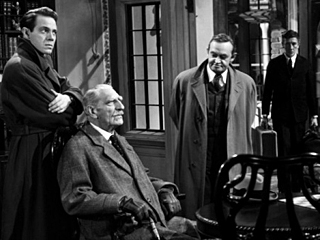 But an island, without having a physical structure, can become a prison, say for those who just might have committed some unknown wrongs. Of the five versions—so far—of Agatha Christie’s Ten Little Indians, the first and best with the writer’s alternate title, And Then There Were None(1945), ten assorted people are invited to Indian Island by a Mr. Owen. All but two are killed and a third, the murderer, poisons himself.
But an island, without having a physical structure, can become a prison, say for those who just might have committed some unknown wrongs. Of the five versions—so far—of Agatha Christie’s Ten Little Indians, the first and best with the writer’s alternate title, And Then There Were None(1945), ten assorted people are invited to Indian Island by a Mr. Owen. All but two are killed and a third, the murderer, poisons himself.
All of this by way of introducing Rawhide (1951) and its stagecoach station, which might as well be an island, so isolated is it for its characters. Tom Owens (Tyrone Power) is an Eastern dude, sent by his father to help at the Rawhide Pass station. Sam Todd (Edgar Buchanan) is the manager.
Arriving on one of the last stages Tom will have to worry about before returning East is Vinnie Holt (Susan Hayward) and a three-year-old niece, Callie (Judy Ann Dunn), daughter of Holt’s late sister, killed in a barroom brawl.
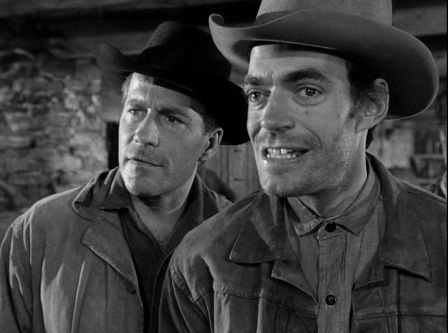 A passing cavalry detachment warns that four convicts have escaped from a nearby prison. When Vinnie and Callie are forcibly removed from the departing stage, the stagecoach company forbidding children to travel in dangerous territory, the determined woman insists on taking Owens’ room.
A passing cavalry detachment warns that four convicts have escaped from a nearby prison. When Vinnie and Callie are forcibly removed from the departing stage, the stagecoach company forbidding children to travel in dangerous territory, the determined woman insists on taking Owens’ room.
Vinnie grabs Tom’s revolver for protection when she and Callie go to a nearby hot springs to bathe.
Later, a man (Hugh Marlowe) on horseback arrives at the station, showing a badge and saying he is Deputy Sheriff Miles on the trail of the convicts. He proves to be the escaped killer Rafe Zimmerman, who signals out of hiding the other three convicts, tagalongs who escaped with him—the obedient Gratz (George Tobias), the slow-witted Yancy (Dean Jagger) and the wild, ready-for-spite Tevis (Jack Elam).
Vinnie, with her charge, witnesses Tevis shoot Sam in the back. She leaves the revolver under a watering trough and attempts to run away (where to?!) before stopped by Yancy. Back in Tom’s room, they agree to pose as man and wife since Rafe has assumed that and Tom feels the mistake might help them stay alive.
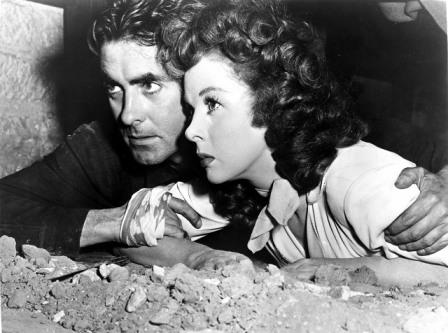 The two attempt to carve a hole in the wall, but, next morning, by the time Rafe forces Tom to hitch up the relief horses for the coming stage, the hole is too small for Vinnie. When Callie crawls through to the outside, Vinnie screams in horror, prompting Tevis to enter and make an advance. Rafe, thinking he has disciplined Tevis, foolishly walks away and Tevis shoots him in the back.
The two attempt to carve a hole in the wall, but, next morning, by the time Rafe forces Tom to hitch up the relief horses for the coming stage, the hole is too small for Vinnie. When Callie crawls through to the outside, Vinnie screams in horror, prompting Tevis to enter and make an advance. Rafe, thinking he has disciplined Tevis, foolishly walks away and Tevis shoots him in the back.
Going outside, Tevis shoots Gratz and attacks Tom, who has now retrieved the revolver from under the trough. They exchange gunfire, Tom from behind the trough and Tevis from behind a woodpile (both firing more shots than their weapons will hold and never reloading). By now Callie has wandered into the open, and Tevis, shooting at the dirt around her, threatens to kill her if Tom doesn’t put down his revolver.
While Tom, hands up, walks toward a teasing Tevis—“Let me see how much guts you got”—Vinnie retrieves a rifle from under Gratz’s body and kills Tevis.
The gold-loaded stagecoach arrives, bringing with it Yancy who had climbed aboard from his post down the trail. Rafe had sent him to watch for the stage, but he seems happier to be going back to prison.
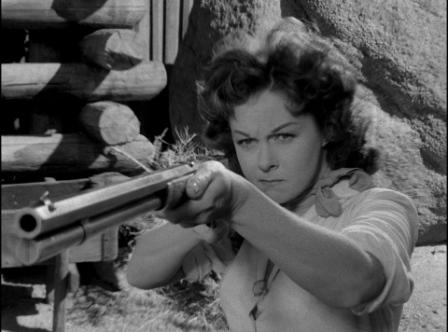 The leering, restless Jack Elam, with the out-of-kilter left eye, practically steals the show. As a highly aggressive outlaw, his performance is inches short of over-the-top and much more vivid than, say, Hugh Marlowe’s, with his usual impassive face. (Compare Elam’s role here with that in Support Your Local Sheriff, 1969, a comic opposite but just as effective.)
The leering, restless Jack Elam, with the out-of-kilter left eye, practically steals the show. As a highly aggressive outlaw, his performance is inches short of over-the-top and much more vivid than, say, Hugh Marlowe’s, with his usual impassive face. (Compare Elam’s role here with that in Support Your Local Sheriff, 1969, a comic opposite but just as effective.)
Notwithstanding other fine acting from the ensemble, Susan Hayward shows convincing fortitude, first indignant toward Tom Owens, then resolute in fighting the fugitives. No underlying romance develops between the two—the tight script and short running time (eighty-six minutes) doesn’t permit it—though there is a distant suggestion at the end. She would make a second picture, Untamed, with Power in 1955.
[embedyt] https://www.youtube.com/watch?v=Ui2DP_ShCLg[/embedyt]
